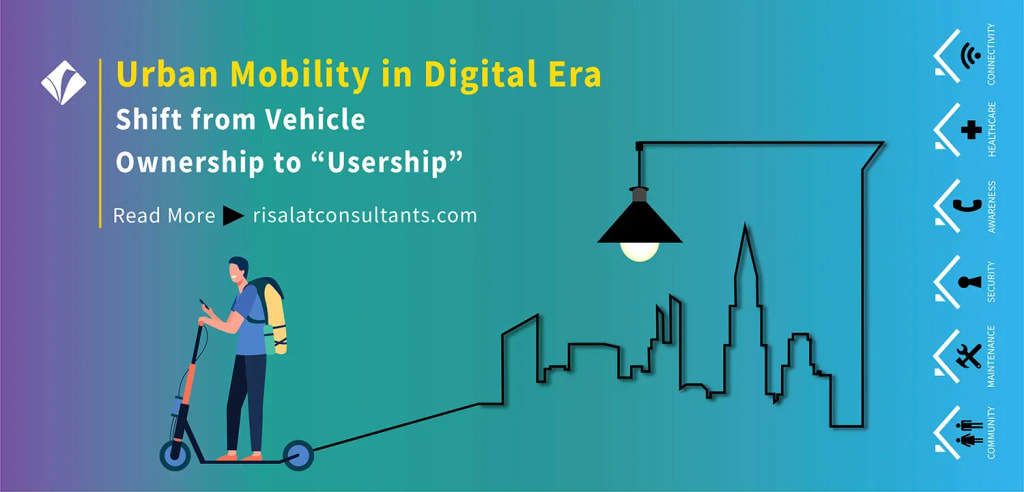Urban Mobility in Digital Era
The shift from Vehicle Ownership to “Usership”

By 2030, most of the world’s population is expected to be concentrated in the cities and if the trend remains, by 2050 nearly 80% of the global community will live in an urban environment. As we already observe the rapid influx of people into cities, many countries come to face several crucial sustainability challenges such as elevated traffic levels, increased congestion, and enhanced carbon emissions and pollution. Contemporary urbanization calls for mobility solutions that are coherent with land use and promote the growth and competitiveness of the cities.
The challenges of urbanization have opened up multiple doors to innovative technologies that are deemed to shape the future of urban mobility. Car and Bike Sharing, On-demand Transport, and Ride-Hailing are becoming more and more common in urban areas across the globe. These App-Based Mobility services are driven by the shift in customers’ mentality from car “ownership” to “usership”. Novel Mobility solutions bear a huge potential to shift the focus from a solo-modal approach to multimodal optimization of entire transport systems. Moreover, such synchronization can greatly contribute to sustainable urban development.
What is Mobility as a Service (MaaS)?
The Concept of Mobility as a Service (MaaS) emerged in 2014 to revolutionize the paradigm of urban mobility. Although the notion took the transport industry by storm, there is no commonly agreed definition for it. The UITP defines MaaS as below:
“Mobility as a Service (MaaS) is the integration of, and access to, different transport services (such as public transport, ride-sharing, car-sharing, bike-sharing, scooter-sharing, taxi, car rental, ride-hailing, and so on) in one single digital mobility offer, with active mobility and an efficient public transport system as its basis. This tailor-made service suggests the most suitable solutions based on the user’s travel needs. MaaS is available anytime and offers integrated planning, booking, and payment, as well as en-route information to provide easy mobility and enable a life without having to own a car.”
In the face of technological development, the era of MaaS has started rendering traditional business models obsolete. MaaS has restructured the mobility distribution chain and created mobility operators that integrate all services into a single solution. Although the implementation of MaaS is currently limited, it would be safe to assume that it does have the potential to be used as a mobility management tool to influence people’s uptake of shared modes.
The very first MaaS product is Whim that is offered by MaaS Global and fully operational in Helsinki expanding to UK and Netherlands. The product proposes numerous approaches to bundling Maas Services fitting them to different socio-economic groups.
How does MaaS Contribute to Sustainable Urban Development?
Several studies have shown that both bike and car-sharing significantly reduce the levels of private vehicle use as well as the vehicle miles traveled. There are many cases where people who started to use shared car services ended up selling their vehicles. Even greater impact can be achieved if we consider the implications of such behavior in the long-term. Assuming MaaS takes care of all the inconveniences associated with not owning a car and younger generations are able to meet the ends of their door-to-door journeys without it, they could easily abandon or delay the idea of purchasing a vehicle. As a consequence, the cities could take great advantage of reduced carbon emission levels and mitigate congestion. When it comes to bike-sharing, it could result in even greater health and lifestyle benefits.
Challenges and Concerns to MaaS Implementation
Regardless of how exciting and appealing the applications of MaaS might sound, there are several confrontations to its implementation. We discuss some of them below:
Implementing and Operating a MaaS service requires a single identity for a user, open data, and open payment methods from different transport modes. Many transport operators are unwilling or even legally prohibited to allow third-party ticket sales. In such tight legal frameworks implementing MaaS would not be feasible.
MaaS can successfully be operated in those cities where different transport modes are available. As public transport is still at the heart of MaaS, a city must have adequate public transport services to replace the alternate need of the user to own a car.
Many users are demonstrating their concerns regarding data tracking as they ask where will MaaS providers draw the ethical line. Even if they are not directly targeted by advertisers, their data will still be pouring into a general big data stream.
Enhanced Levels of Concern are associated with the competitiveness of MaaS when expanding from local to a global market. In this case, many argue that big players could promote unfair competition between themselves and SMEs on the market.
MaaS can trigger the slowdown of innovation in the urban mobility market that has been observing several notable advancements throughout the recent decades.
About the Creator
Risalat Consultants International LLC
Risalat Consultants | Business - Consulting - Research - Workshops
https://risalatconsultants.com/






Comments
There are no comments for this story
Be the first to respond and start the conversation.